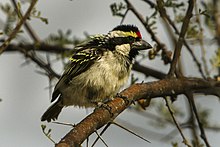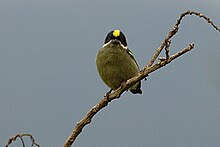African bearded birds
| African bearded birds | ||||||||||
|---|---|---|---|---|---|---|---|---|---|---|

Collared bearded birds ( Lybius torquatus ) |
||||||||||
| Systematics | ||||||||||
|
||||||||||
| Scientific name | ||||||||||
| Lybiidae | ||||||||||
| Sibley & Ahlquist , 1985 |
The African bearded birds (Lybiidae) are a family of woodpeckers found in sub-Saharan Africa with the exception of the arid areas in South Africa, Namibia and Botswana and north-east Somalia.
features
African bearded birds are usually brightly colored, with the males being more colorful than the females. Reddish or yellowish tones are particularly common, but many species also have black or white plumage. The birds are nine to 24 centimeters long. The trunk is short, the neck short and thick, and the head can be relatively large in relation to the body. The beak is large and heavy and often has a saw on the edges. In some species, most of the head is featherless. The wings are medium-long and rounded, the tail is medium-long and angular at the end. As with the woodpeckers , the first and fourth toes point backwards, the second and third forwards (zygodactyl toe arrangement). Of all the bearded bird families, the African bearded birds show the greatest morphological diversity.
Way of life and reproduction
African bearded birds live in different biotopes from savannas to rainforests. They prefer to eat fruits, especially figs. They also eat insects more than other bearded birds. These are caught on the ground or in the branches of trees and bushes; some species also prey on them in flight. Of all bearded families, the African bearded birds spend most of their time on the ground.
Most African bearded birds are monogamous and both parents are involved in the breeding business, rearing the young and keeping the nest clean. Many, e.g. B. the species of bristle- bearded mustache ( Gymnobucco ) breed in colonies, sometimes together with other bearded bird species. All African bearded birds are cave breeders and, like most cave breeders, lay white eggs. The nests are timbered in the soft wood of dead trees or, in the case of trachyphonus ( Trachyphonus dug on steep banks or termite mounds). The clutch size varies between one and seven eggs. The eggs are incubated for 12 to 18 days. After hatching, the nestlings are primarily fed insects; with increasing age, more and more fruits are added. The young bearded birds fledge after 20 to 35 days.
Systematics
All African bearded birds originally belonged together with the Asian and South American bearded birds to a uniform bearded bird family , which had the scientific name Capitonidae, which is still valid today for the American bearded birds . According to DNA hybridization studies by the American ornithologists and molecular biologists Charles Sibley and Jon Edward Ahlquist , the bearded birds do not form a monophyletic group without the toucans (Ramphastidae) . Independent families were therefore introduced for the African and Asian bearded birds (Lybiidae and Megalaimidae ). The research of Sibley and Ahlquist was later confirmed by DNA comparisons . The African bearded birds stand at the base of a clade that includes the American bearded birds (Capitonidae), the toucan bearded birds (Semnornithidae) and the toucans (Ramphastidae). These four families are the sister group of the Asian bearded birds (Megalaimidae).
Genera and species
- Subfamily Lybiinae
 Bald Beard Bird ( Gymnobucco calvus )
Bald Beard Bird ( Gymnobucco calvus )- Genus Buccanodon
- Yellow-spotted bearded bird ( Buccanodon duchaillui )
- Genus bristle mustache ( Gymnobucco )
- Black Bearded Bird ( Gymnobucco bonapartei )
- Bald Beard Bird ( Gymnobucco calvus )
- Borstenbartvogel , Pelbartvogel ( Gymnobucco peli )
- Sootbeard bird ( Gymnobucco sladeni )
- Genus tooth-bearded birds ( Lybius )
 Double-toothed bearded bird ( Lybius bidentatus )
Double-toothed bearded bird ( Lybius bidentatus )- Double-toothed bearded bird ( Lybius bidentatus )
- Fig bearded bird ( Lybius chaplini )
- Senegal Furchenschnabel , Furchenschnabelvogel ( Lybius dubius )
- Purple mask bearded bird ( Lybius guifsobalito )
- Bald Bearded Bird ( Lybius leucocephalus )
- Brown-breasted bearded bird ( Lybius melanopterus )
- Rose-bellied bearded bird ( Lybius minor )
- Black-breasted fur -beak ( Lybius rolleti )
- Red-faced bearded bird ( Lybius rubrifacies )
- Collared bearded bird or black-necked bearded bird ( Lybius torquatus )
- Bartvogel shaft ( Lybius undatus )
- Blood-breasted bearded bird ( Lybius vieilloti )
- Genus dwarf bearded birds or dwarf mustaches ( Pogoniulus )
- Red- rump bearded bird ( Pogoniulus atroflavus )
- Yellow-tufted dwarf bearded or banded dwarf bearded ( Pogoniulus bilineatus )
- Yellow-fronted bearded bird or yellow-fronted dwarf bearded ( Pogoniulus chrysoconus )
- Yellow-bridged bearded bird ( Pogoniulus coryphaeus )
- Mountain bearded bird ( Pogoniulus leucomystax )
- Makawa bearded bird ( Pogoniulus makawai )
- Fire-browed bearded bird ( Pogoniulus pusillus )
- Spotted dwarf mustard or shed dwarf mustard ( Pogoniulus scolopaceus )
- Plain bearded bird ( Pogoniulus simplex )
- Yellow-throated dwarf bearded ( Pogoniulus subsulphureus )
- Genus Stactolaema
 Red-fronted bearded bird ( Tricholaema leucomelas )
Red-fronted bearded bird ( Tricholaema leucomelas )- Straw-headed bearded bird ( Stactolaema anchietae )
- White-eared bearded bird ( Stactolaema leucotis )
- Olive whisker ( Stactolaema olivacea )
- Mirror bearded bird ( Stactolaema whytii )
- Genus Haarbärtlinge ( Tricholaema )
- Diadem hair beard ( Tricholaema diademata )
- Miombo bearded bird ( Tricholaema frontata )
- Spotted bearded bird ( Tricholaema hirsuta )
- Diadem Bearded Bird ( Tricholaema lacrymosa )
- Red-fronted bearded bird ( Tricholaema leucomelas )
- Black-headed bearded bird ( Tricholaema melanocephala )
- Genus Buccanodon
- Subfamily Trachyphoniinae
 Flamehead bearded bird ( Trachyphonus erythrocephalus )
Flamehead bearded bird ( Trachyphonus erythrocephalus )- Genus bearded birds ( Trachyphonus )
- Latticed bearded bird ( Trachyphonus darnaudii )
- Flamehead bearded bird ( Trachyphonus erythrocephalus )
- Perlbartvogel ( Trachyphonus margaritatus )
- Yellow-billed bearded bird ( Trachyphonus purpuratus )
- Crested bearded bird or black-backed bearded bird ( Trachyphonus vaillantii )
- Genus bearded birds ( Trachyphonus )
supporting documents
- ↑ a b c d e David W. Winkler, Shawn M. Billerman, Irby J. Lovette: Bird Families of the World: A Guide to the Spectacular Diversity of Birds. Lynx Edicions (2015), ISBN 978-8494189203 . Page 243 a. 244.
- ^ Sibley, CG, & Ahlquist, JE (1985). The relationships of some groups of African birds, based on comparisons of the genetic material, DNA. Incl. Schuchmann (Ed.), Proceedings of the International Symposium on African Vertebrates : 115-161. Bonn: Zoological Research Institute and Museum Koenig.
- ↑ Hackett et al .: A Phylogenomic Study of Birds Reveals Their Evolutionary History . Science June 27, 2008: Vol. 320. no. 5884, pp. 1763–1768 doi : 10.1126 / science.1157704
